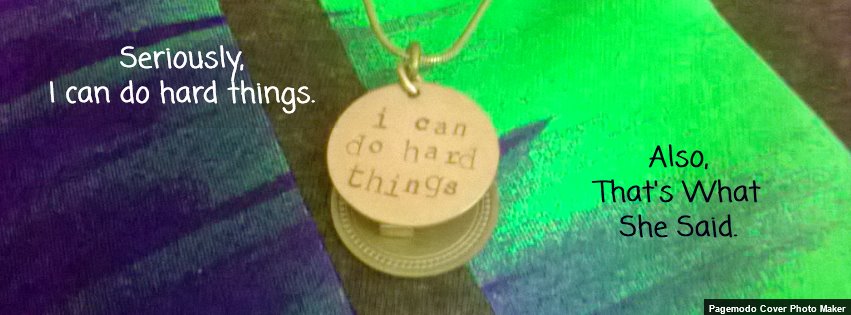A trigger toolkit is a collection of skills and tangible items that allow us to cope with the effects of our trauma in healthy ways.
For instance, when I work with clients in my office or with Zoom, I always wear a necklace. My necklaces have prominent pendants that are good for fidgeting. I like to fidget because it helps me to listen and focus on what’s happening with the other person.
These necklaces also help me to ground. One pendant – my favorite, actually – is a round piece of metal that has “I can do hard things” stamped into it. When my nervous system is activated or I’ve been emotionally triggered, I run my fingertips over the stamped letters. It serves more than one purpose; I am reminded of what I have already overcome, I’m grounded with a tangible way to an object of hope, and I’m soothed by the smoothness of the metal.
How Triggers Work
While the word “trigger” is used fast and loose in our culture, this word has a specific meaning when it comes to PTSD and trauma experiences.
First, let’s talk about nervous system activation, which is the part of our wiring that produces a fight, flight, or freeze response that is typically quickly resolved. For example, if someone in traffic swerves unexpectedly and almost hits you with their car, your nervous system may become activated but will quickly go back to calm.
A trigger, however, is subconscious and tied to our trauma experiences. Here’s an example: I go into a room. I smell Aqua Velva after shave. The smell puts me right back when I was seven years old, with my abusive father. I can’t breathe. I scan the room for danger and exits. My body panics and I feel nauseous. Full-on nervous system activation.
A trigger is when something jolts you into a visual or emotional flashback, like you are back in the trauma. It’s your fire alarm system going off when there is the memory of a fire, but you are in no danger. Many triggers result in a fight, flight, freeze, or fawn response, but not always. Some triggers can be anticipated, while others seem to come out of nowhere.
Triggers can be caused by hearing fireworks (this one is super common), new reports, or seeing or smelling something that is from the traumatic event.
Basically, our warning system is stuck in the ON position (PTSD Remediation resets our systems back into a more “normal” function).
Parts of a Trigger Toolkit
First, an important point, which is: USE WHAT WORKS.
Use your favorite coping skills in your trigger toolkit. This will help you remember what they are when you are triggered.
Also, who wants to keep doing something that they don’t like? Not me. If you try something and it doesn’t work or you don’t like it, chuck it. Maybe try something new. Also, keep in mind that it may take more than one tool to get through a trigger, along with time.
The best Trigger Toolkits have a variety of tools. The categories that I’ve learned when building my own trauma recovery toolkit are Grounding, Resolving, Affirming, Distracting, and Self-Soothing.
Grounding: these interrupt the overwhelming feelings and thoughts swirling around inside our heads by shifting our attention to our bodies which helps us feel calmer, more focused, and more in control of ourselves
Resolving: these address the underlying cause of particular triggers so that they are no longer a source of our being triggered in the future
Affirming: these directly impact the way we talk to and think about ourselves and our triggers, making it easier for us to feel in control of our triggers rather than being at their mercy
Distracting: these strategies do not resolve or change our response to a trigger. Instead they shift our focus from the emotional and physical response to the trigger onto a calmer, emotionally neutral situation or event. This effectively starves our trigger response and it dissipates without our attention
Self-Soothing: these are strategies we can implement to soothe and calm the distress caused by a trigger
Start Your Trigger Toolkit
Here is a downloadable tool that goes into more detail about what strategies are in each category.
This is by no means an exhaustive list. And you likely already use tools that can be put into one or more of these categories. Take note of the tools already in your toolkit.
Happy building!
Curious if your trauma symptoms are related to PTSD? Take this FREE PTSD Quiz to find out!)
Latest Posts
- I Am A Survivor & Every Step Counts (Paris Storytelling Video Series)
- Losing Hope? Responsibility and Toilet Humor
- Reigniting Belief in Myself Storytime! (Paris Storytelling Video Series)
- Losing Hope? The Second Essential Skill to Reignite Hope
- Resource for Working Through Political Grief
Try Trauma Recovery & Grief Recovery Coaching

Sign up here to get a free copy of Five Things Every Trauma Survivor Needs to Know AND
61 Tips About the Grief Experience.
Find out more about Trauma and Grief Recovery Coaching
I offer one-on-one sessions, groups, PTSD Remediation, and classes. Appointments are offered in-person and online.
Try Trauma Recovery and Grief Recovery Coaching for Free! Book a free 30-minute Discovery Call to find out more!
